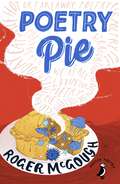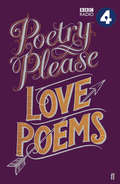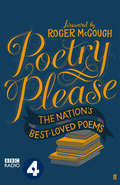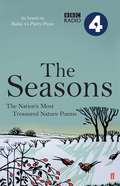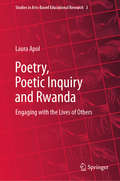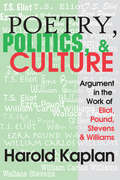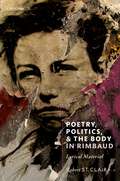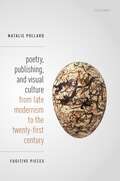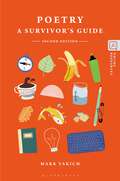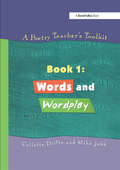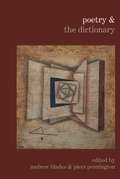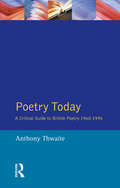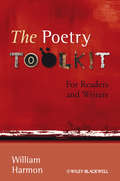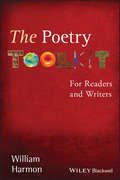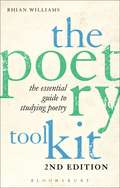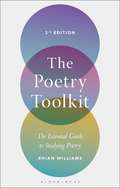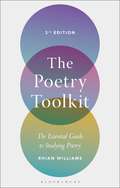- Table View
- List View
Poetry Pie (Puffin Poetry)
by Roger McGoughPOETRY PIE is a brilliant collection of poems for children by Roger McGough, There are over 50 poems in this hugely enjoyable poetry collection with themes ranging from food and animals to school and ghouls. As always, Roger Mcgough's poems are full of wit and wisdom, with word play, puns and sharp observations on all aspects of life. He has included his own unique line drawings which are full of humour and pathos. Children are sure to ask for another slice of this brand new poetry pie!Roger McGough is one of the UK's most celebrated and distinctive poets. He is the author of more than fifty books and has written numerous scripts, including the script for the Beatles' film Yellow Submarine. He is an international ambassador for poetry and in 1997 was awarded an OBE.
Poetry Please: Love Poems
by Various Poets'What will survive of us is love.'In this new anthology poets from across the ages lead us on a journey of love in its many forms. From Shakespeare to Rossetti, Keats to Auden, Byron to Browning an beyond, as well as a host of contemporary voices including Wendy Cope, Simon Armitage and Carol Ann Duffy, this new gathering of timeless love poems speaks to the heart about this most universal of themes.Whether in marriage or heartbreak, friendship or infatuation, whether in pursuit of the unattainable ideal or else settling down together for life, whether in love or out of it, you will find poems here to touch the heart. A vital assembly of our most treasured and enduring love poems.
Poetry Please
by Various PoetsBBC Radio 4's Poetry Please is the longest-running broadcast of verse anywhere in the world. First aired in 1979, the programme, a request show which broadcasts to two million listeners a week, has become a unique record of the country's best-loved poems over the decades since its inception. The BBC has looked back through its rich archive of recordings to produce a poll of the most asked for and most broadcast pieces ever: it is those poems that this anthology brings together here. A showcase, in effect, for the nation's favourite verse, Poetry Please is a treasure trove for our most requested and most listened to poems of all time. It is a compelling invitation for readers of all ages and backgrounds to celebrate the verse that we care so much about: from new readers to old, from schools to reading groups, this a book for giving, a book for cherishing.
Poetry Please: The Seasons
by Various PoetsThis new anthology of poems, favourites from the nation's longest-running and best-loved request programme for verse, moves with the seasons, following the turning year from John Clare's 'pale splendour of the winter sun' to John Keats's 'Season of mists and mellow fruitfulness', by way of Larkin's 'young-leafed June' and Gerard Manley Hopkins' 'glassy peartree leaves and blooms' when 'Nothing is so beautiful as Spring'. As the year changes, so we change with it. Since time out of mind our daily lives have been shaped and directed by the seasons, and it is here that we find poems about harvest and hardship, growth and new life, the warmth of the life-giving sun, Christmas and the closing of the year. Poetry Please: Seasonal Poems is a vital and generous gathering to treasure.
Poetry, Poetic Inquiry and Rwanda: Engaging with the Lives of Others (Studies in Arts-Based Educational Research #3)
by Laura ApolThis book describes the practice of poetic inquiry and takes the reader through the process of translating lived experience into poetry that attends to the lives of others. Using her own writing—from early drafts to published poems—Apol demonstrates elements of poetic inquiry that both give it strength and make it complicated: the importance of craft (the aesthetic); the imperative of accuracy and reliability (the investigative); the significance of ethical responsibility that leads to action (witness); and the centrality of relational connectedness and accountability (withness). Apol raises questions about what it means for poems to function as both research and art, and illustrates what happens when there are irresolvable conflicts between the demands of the poem and a commitment to relationship. Throughout, Apol addresses her white privilege, as well as the dominant white/colonial narrative that often seeps into arts-based work unless it is overtly and critically addressed. The book goes beyond arts-based research, speaking as well to other forms of cross-national, cross-cultural research. It is a call for relational scholarship that moves toward action, a heart-rending teaching, a post-traumatic aesthetic map laid down with clear and poignant theory and praxis to extend, serve and guide.
Poetry, Politics, and Culture: Argument in the Work of Eliot, Pound, Stevens, and Williams
by Harold KaplanA salient feature of modern poetics is its direct connection with cultural history and politics. Among the great American poets of the twentieth century, Wallace Stevens and William Carlos Williams offer a significant contrast with T. S. Eliot and Ezra Pound. Where the latter advocated a theocentric or reactionary response to the cultural crises of modernity, the former affirmed an essentially humanist and democratic social and aesthetic ethos. In Poetry, Politics, and Culture, Harold Kaplan offers a penetrating comparative study of these representative and distinctively influential poets.All four poets wrote in an atmosphere of cultural crisis following World War I, caught as they were between outmoded belief systems and various forms of artistic and political nihilism. While each believed in poetry as a source of cultural values and beliefs, they nevertheless experienced loss of confidence in their own vocation in a world characterized by scientific, rationalist thinking and the mundane struggle for survival. For each, therefore, the poetic imagination was a means of restoring order, or building a new civilization out of chaos. In trying to define a revitalized culture, the four exemplified the perennial quarrel between Europe and America.
Poetry, Politics, and Culture: Argument in the Work of Eliot, Pound, Stevens, and Williams
by Harold KaplanA salient feature of modern poetics is its direct connection with cultural history and politics. Among the great American poets of the twentieth century, Wallace Stevens and William Carlos Williams offer a significant contrast with T. S. Eliot and Ezra Pound. Where the latter advocated a theocentric or reactionary response to the cultural crises of modernity, the former affirmed an essentially humanist and democratic social and aesthetic ethos. In Poetry, Politics, and Culture, Harold Kaplan offers a penetrating comparative study of these representative and distinctively influential poets.All four poets wrote in an atmosphere of cultural crisis following World War I, caught as they were between outmoded belief systems and various forms of artistic and political nihilism. While each believed in poetry as a source of cultural values and beliefs, they nevertheless experienced loss of confidence in their own vocation in a world characterized by scientific, rationalist thinking and the mundane struggle for survival. For each, therefore, the poetic imagination was a means of restoring order, or building a new civilization out of chaos. In trying to define a revitalized culture, the four exemplified the perennial quarrel between Europe and America.
Poetry, Politics, and the Body in Rimbaud: Lyrical Material
by Robert St. ClairBodies abound in Rimbaud's poetry in a way that is nearly unprecedented in the nineteenth-century poetic canon: lazy, creative, rule-breaking bodies, queer bodies, marginalized and impoverished bodies, revolting and revolutionary, historical bodies. The question that Poetry, Politics, and the Body seeks to answer is: What does this corporeal density mean for reading Rimbaud? What kind of sense are we to make of this omnipresence of the body in the Rimbaldian corpus, from first to last–from the earliest poems in verse celebrating the sheer, simple delight of running away from wherever one is and stretching one's legs out under a table, to the ultimate flight away from poetry itself? In response, this book argues that the body appears–often literally–as a kind of gap, breach, or aperture through which Rimbaud's poems enter into contact with history and a larger body of other texts. Simply put, the body is privileged 'lyrical material' for Rimbaud: a figure for human beings in their exposed, finite creatureliness and in their unpredictable agency and interconnectedness. Its presence in the early work allows us not only to contemplate what a strange, sensuous thing it is to be embodied, to be both singular and part of a collective, it also allows the poet to diagnose, and the reader to perceive, a set of seemingly intractable, 'real' socio-economic, political, and symbolic problems. Rimbaud's bodies are, in other words, utopian bodies: sites where the historical and the lyrical, the ideal and the material, do not so much cancel each other out as become caught up in one another.
Poetry, Politics, and the Body in Rimbaud: Lyrical Material
by Robert St. ClairBodies abound in Rimbaud's poetry in a way that is nearly unprecedented in the nineteenth-century poetic canon: lazy, creative, rule-breaking bodies, queer bodies, marginalized and impoverished bodies, revolting and revolutionary, historical bodies. The question that Poetry, Politics, and the Body seeks to answer is: What does this corporeal density mean for reading Rimbaud? What kind of sense are we to make of this omnipresence of the body in the Rimbaldian corpus, from first to last–from the earliest poems in verse celebrating the sheer, simple delight of running away from wherever one is and stretching one's legs out under a table, to the ultimate flight away from poetry itself? In response, this book argues that the body appears–often literally–as a kind of gap, breach, or aperture through which Rimbaud's poems enter into contact with history and a larger body of other texts. Simply put, the body is privileged 'lyrical material' for Rimbaud: a figure for human beings in their exposed, finite creatureliness and in their unpredictable agency and interconnectedness. Its presence in the early work allows us not only to contemplate what a strange, sensuous thing it is to be embodied, to be both singular and part of a collective, it also allows the poet to diagnose, and the reader to perceive, a set of seemingly intractable, 'real' socio-economic, political, and symbolic problems. Rimbaud's bodies are, in other words, utopian bodies: sites where the historical and the lyrical, the ideal and the material, do not so much cancel each other out as become caught up in one another.
Poetry, Publishing, and Visual Culture from Late Modernism to the Twenty-first Century: Fugitive Pieces
by Natalie PollardThis is a book about contemporary literary and artistic entanglements: word and image, media and materiality, inscription and illustration. It proposes a vulnerable, fugitive mode of reading poetry, which defies disciplinary categorisations, embracing the open-endedness and provisionality of forms. This manifests itself interactively in the six case studies, which have been chosen for their distinctness and diversity across the long twentieth century: the book begins with the early twentieth-century work of writer and artist Djuna Barnes, exploring her re-animation of sculptural and dramatic sources. It then turns to the late modernist artist and poet David Jones considering his use of the graphic and plastic arts in The Anathemata, and next, to the underappreciated mid-century poet F.T. Prince, whose work uncannily re-activates Michelangelo's poetry and sculpture. The second half of the book explores the collaborations of the canonical poet Ted Hughes with the publisher and artist Leonard Baskin during the 1970s; the innovative late twentieth-century poetry of Denise Riley who uses page space and embodied sound as a form of address; and, finally, the contemporary poet Paul Muldoon who has collaborated with photographers and artists, as well as ventriloquising nonhuman phenomena. The resulting unique study offers contemporary writers and readers a new understanding of literary, artistic, and nonhuman practices and shows the cultural importance of engaging with their messy co-dependencies. The book challenges critical methodologies that make a sharp division between the textual work and the extra-literary, and raises urgent questions about the status and autonomy of art and its social role.
Poetry, Publishing, and Visual Culture from Late Modernism to the Twenty-first Century: Fugitive Pieces
by Natalie PollardThis is a book about contemporary literary and artistic entanglements: word and image, media and materiality, inscription and illustration. It proposes a vulnerable, fugitive mode of reading poetry, which defies disciplinary categorisations, embracing the open-endedness and provisionality of forms. This manifests itself interactively in the six case studies, which have been chosen for their distinctness and diversity across the long twentieth century: the book begins with the early twentieth-century work of writer and artist Djuna Barnes, exploring her re-animation of sculptural and dramatic sources. It then turns to the late modernist artist and poet David Jones considering his use of the graphic and plastic arts in The Anathemata, and next, to the underappreciated mid-century poet F.T. Prince, whose work uncannily re-activates Michelangelo's poetry and sculpture. The second half of the book explores the collaborations of the canonical poet Ted Hughes with the publisher and artist Leonard Baskin during the 1970s; the innovative late twentieth-century poetry of Denise Riley who uses page space and embodied sound as a form of address; and, finally, the contemporary poet Paul Muldoon who has collaborated with photographers and artists, as well as ventriloquising nonhuman phenomena. The resulting unique study offers contemporary writers and readers a new understanding of literary, artistic, and nonhuman practices and shows the cultural importance of engaging with their messy co-dependencies. The book challenges critical methodologies that make a sharp division between the textual work and the extra-literary, and raises urgent questions about the status and autonomy of art and its social role.
Poetry & Strikes: Trade Union Narratives and Legacies (Poetry &... #12)
by Michael JamesPoetry & Strikes examines shifting representations of strike action in the work of six British poets from the 1970s to the present day. It considers how these poets have come to contend with, and contribute to, narratives surrounding industrial disputes. Through these conversations, the book attempts to question the way in which union narratives and legacies are constructed, and to investigate the power dynamics that underpin the presentation of labour histories. The work of these poets helps us to understand how cultural memories have been formed, and makes it possible to see how these legacies may still be rewritten and reframed.
Poetry The Student Toolkit Literary Eye GCSE English Second Edition (PDF)
by Steve EddyThe student guide to how poetry works and responding to poetry.
Poetry: A Survivor's Guide
by Mark YakichPoetry: A Survivor's Guide has earned high praise from students, teachers, and readers from around the globe for its playful sincerity and idiosyncratic humor and for its approach to a subject both loved and feared. Updated and expanded, including six new sections, the second edition probes a range of strategies for inspiring students and aspiring poets on the ways poetry relates to their own lives. These include the delights and pitfalls of individual meditation, the complications of identity and appropriation, and the uses and utility of poetry as a tool of social change.The second edition also includes a curated companion website for teachers, students, and aspiring poets that features poetry examples, writing prompts and exercises, and resources for publishing poetry.
Poetry: A Survivor's Guide
by Mark YakichPoetry: A Survivor's Guide has earned high praise from students, teachers, and readers from around the globe for its playful sincerity and idiosyncratic humor and for its approach to a subject both loved and feared. Updated and expanded, including six new sections, the second edition probes a range of strategies for inspiring students and aspiring poets on the ways poetry relates to their own lives. These include the delights and pitfalls of individual meditation, the complications of identity and appropriation, and the uses and utility of poetry as a tool of social change.The second edition also includes a curated companion website for teachers, students, and aspiring poets that features poetry examples, writing prompts and exercises, and resources for publishing poetry.
A Poetry Teacher's Toolkit: Book 1: Words and Wordplay
by Collette Drifte Mike JubbProfessional poets spend many hours crafting a finished piece of work, yet we expect children in school to sit down and write when they are told to, whether they feel inspired or not. This series of four books is a toolkit to help you build a positive framework for children to read, write, understand and enjoy poetry - to bring a creative spark to the poetry classroom. A combination of featured poems, creative ideas, structured lesson plans and differentiated photocopiable activity sheets gives the series a uniquely flexible approach - which means you can use the materials in any classroom context. If you're wary of poetry, if you think it's boring, or if you're nervous about teaching poetry, then you've chosen the right book. Key themes covered in BOOK 1: Words and Wordplay are playing with words; making patterns with words; words and meanings; puns and puzzles; how words affect readers; moods, feelings and attitudes; and how poets manipulate words. Other books in the series are: BOOK 2: Rhymes, Rhythms and Rattles; BOOK 3: Style, Shape and Structure; and BOOK 4: Language and Performance.
A Poetry Teacher's Toolkit: Book 1: Words and Wordplay
by Collette Drifte Mike JubbProfessional poets spend many hours crafting a finished piece of work, yet we expect children in school to sit down and write when they are told to, whether they feel inspired or not. This series of four books is a toolkit to help you build a positive framework for children to read, write, understand and enjoy poetry - to bring a creative spark to the poetry classroom. A combination of featured poems, creative ideas, structured lesson plans and differentiated photocopiable activity sheets gives the series a uniquely flexible approach - which means you can use the materials in any classroom context. If you're wary of poetry, if you think it's boring, or if you're nervous about teaching poetry, then you've chosen the right book. Key themes covered in BOOK 1: Words and Wordplay are playing with words; making patterns with words; words and meanings; puns and puzzles; how words affect readers; moods, feelings and attitudes; and how poets manipulate words. Other books in the series are: BOOK 2: Rhymes, Rhythms and Rattles; BOOK 3: Style, Shape and Structure; and BOOK 4: Language and Performance.
Poetry & the Dictionary (Poetry &... #8)
Poetry is an ancient verbal art, which has its roots in the oral epics and fragments that survive from classical times. Dictionaries of English, by contrast, are a comparatively recent phenomenon, beginning with the ‘hard words’ that Robert Cawdrey gathered in A Table Alphabeticall in 1604 and extending to the present edition of the Oxford English Dictionary, with its ongoing revisions. This innovative collection of essays is the first volume to explore the ways in which dictionaries have stimulated the imaginations of modern and contemporary poets from Britain, Ireland, and America, while also considering how poetry has itself been a rich source of material for lexicographers. As well as gauging the influence of major dictionaries like the OED, the essays single out encounters with more specialised works and broach uses of words that are not typically included in dictionaries. In doing so, the contributors not only cast familiar questions of ambiguity and etymology in a fresh light, but they also reveal a number of surprising and energising points of contact, from Hugh MacDiarmid’s rediscovery of Scots to Tina Darragh’s visual appropriations of dictionary pages. As such, Poetry & the Dictionary will prove an indispensable volume for all readers – academic or not – who find themselves fascinated by the language’s many involutions.
Poetry Today: A Critical Guide to British Poetry 1960-1995
by Anthony ThwaiteThis is the most authoritative and up to date survey of contemporary British poetry 1960-1995. It is the third version but second edition published by Longman of a successful survey that first appeared 30 years ago, and provides a succinct and accessible overview of British poets, movements and themes, ideal for English courses and the general reader alike.
Poetry Today: A Critical Guide to British Poetry 1960-1995
by Anthony ThwaiteThis is the most authoritative and up to date survey of contemporary British poetry 1960-1995. It is the third version but second edition published by Longman of a successful survey that first appeared 30 years ago, and provides a succinct and accessible overview of British poets, movements and themes, ideal for English courses and the general reader alike.
The Poetry Toolkit: For Readers and Writers
by William HarmonThe Poetry Toolkit: For Readers and Writers provides students with the essential intellectual and practical tools necessary to read, understand, and write poetry. Explains the most important elements of poetry in clear language and an easily accessible manner Offers readers both the expertise of an established scholar and the insights of a practicing poet Draws on examples from more than 1,500 years of English literature
The Poetry Toolkit: For Readers and Writers
by William HarmonThe Poetry Toolkit: For Readers and Writers provides students with the essential intellectual and practical tools necessary to read, understand, and write poetry. Explains the most important elements of poetry in clear language and an easily accessible manner Offers readers both the expertise of an established scholar and the insights of a practicing poet Draws on examples from more than 1,500 years of English literature
The Poetry Toolkit: 2nd Edition
by Rhian WilliamsWith examples from an extensive range of poets from Chaucer to today, The Poetry Toolkit offers simple and clear explanations of key terms, genres and concepts that enable readers to develop a richer, more sophisticated approach to reading, thinking and writing about poems. Combining an easy-to-use reference format defining and illustrating key concepts, forms and topics, with in-depth practice readings and further exercises, the book helps students master the study of poetry for themselves. Now in its second edition, The Poetry Toolkit includes a wider range of examples from contemporary poetry and more American poetry. In addition, an extended close reading section now offers practice comparative readings of the kind students are most likely to be asked to undertake, as well as readings informed by contemporary environmental and urban approaches. The book is also supported by extensive online resources, including podcasts, weblinks, guides to further reading and advanced study guides to reading poetry theoretically.
The Poetry Toolkit: The Essential Guide to Studying Poetry
by Rhian WilliamsNow thoroughly revamped with a diverse selection of poetic voices from the last fifty years, this third edition of Rhian Williams's bestselling book, The Poetry Toolkit guides readers through key terms, genres and concepts that help them to develop a richer, more sophisticated approach to reading, thinking and writing about poetry. Combining an easy-to-use reference format with in-depth practice readings and further exercises, the book helps students master the study of poetry for themselves. As well as featuring more contemporary voices, the 3rd edition of The Poetry Toolkit includes an expanded practical section giving guidance on close reading, comparative reading and advice on writing critically about poetry. In addition, the book is accompanied by a companion website offering audio recordings of poetry readings, weblinks and overviews of key theoretical approaches to support advanced study. Head to bloomsbury.com/Williams-the-poetry-toolkit for a host of additional resources.
The Poetry Toolkit: The Essential Guide to Studying Poetry
by Rhian WilliamsNow thoroughly revamped with a diverse selection of poetic voices from the last fifty years, this third edition of Rhian Williams's bestselling book, The Poetry Toolkit guides readers through key terms, genres and concepts that help them to develop a richer, more sophisticated approach to reading, thinking and writing about poetry. Combining an easy-to-use reference format with in-depth practice readings and further exercises, the book helps students master the study of poetry for themselves. As well as featuring more contemporary voices, the 3rd edition of The Poetry Toolkit includes an expanded practical section giving guidance on close reading, comparative reading and advice on writing critically about poetry. In addition, the book is accompanied by a companion website offering audio recordings of poetry readings, weblinks and overviews of key theoretical approaches to support advanced study. Head to bloomsbury.com/Williams-the-poetry-toolkit for a host of additional resources.
